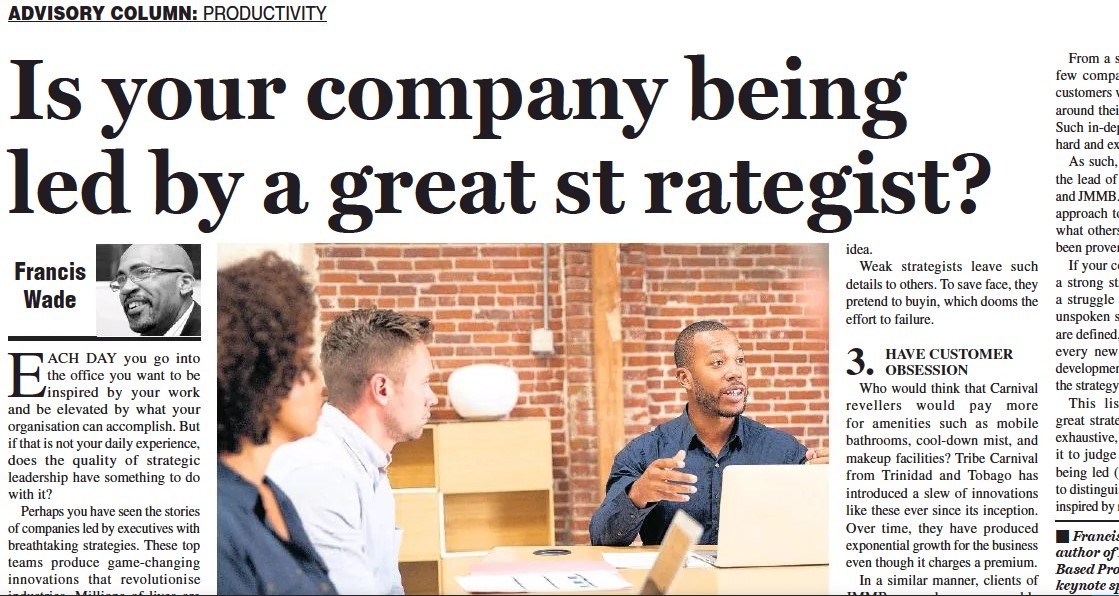Each day you go into the office, you want to be inspired by your work. Elevated by what your organization can accomplish. But if that’s not your daily experience, does the quality of strategic leadership have something to do with it?
Perhaps you have seen the stories of companies led by executives with breathtaking strategies. These top teams produce game-changing innovations which revolutionize industries. Millions of lives are transformed. The likes of Facebook and Netflix displace also-rans who look stale by comparison, capturing hearts and minds in every corner of the world.
But when you compare what happens in these model organizations with your own, you see a big gap. Are you making an unfair contrast? Are the elements you focus on the right ones to examine? What are the naked truths you wish you could explain to your leaders if you had the chance?
- Bold Vision
COVID has led many CEO’s to limit the scope of what they say they want to achieve. Times are hard and uncertain, they admit, and things are changing too fast to think about big goals.
All they have is energy for survival. A vision would be a distraction.
Unfortunately, research shows they are likely to fail. Creating Big Hairy Audacious Goals (BHAGs) is, according to Jim Collins and Jerry Porras of Built to Last fame, essential. Their comparison between companies that use BHAGs versus those which don’t is stark.
However, this doesn’t mean you should throw together yet another vision statement. In fact, these pronouncements can damage productivity if they are vague, undated and insulting to the average person’s intelligence. When employees deduce a lack of seriousness, such declarations destroy motivation.
Instead of nebulous promises to be “world class”, create the kind of vision that paints a clear picture of a single destination. This means it must have a date, and an unequivocal set of target metrics, at minimum.
- Feasible Pathway
BHAGs are an essential part of great strategies, but in 2022, they aren’t enough. We have become more immune to aspirational statements than we were in 1994 when Collins/Porras published their book. Why? Oftentimes they include little more than wishful thinking.
The way to bring corporate dreams into existence is to go deeper in the planning stages. How? Craft a credible pathway between today’s reality and the final destination.
This is no easy feat to accomplish. It takes a small team an intense effort to lay out a plan that covers 15-30 years. It gets complicated: within each time period, certain financial and operational milestones must be hit.
While there are projects introduced during this planning horizon that drive the numbers, these should be realistic. In fact, it pays to be conservative.
This powerful exercise forces teams to confront realities that otherwise would be ignored. For example, a client’s strategy called for entering Latin America in a big way. The price? Moving the company’s headquarters to Miami.
This was too heavy a tax to pay and the plan was moderated.
Another client required the acquisition of competitors. But the firm had never undertaken such an activity and would need to hire expensive specialists. It shelved the idea.
Weak strategists leave such details to others. To save face, they pretend to buy-in, which dooms the effort to failure.
- Customer Obsession
Who would think that Carnival revellers would pay more for amenities such as mobile bathrooms, cool-down mist and makeup facilities? Tribe Carnival from Trinidad and Tobago has introduced a slew of innovations like these ever since its inception. Over time, they have produced exponential growth for the business, even though it charges a premium.
In a similar manner, clients of JMMB swear by a comparable approach to innovation in its investment operations. Like Tribe, the company has a relentless focus on the customer that leads it to do things other institutions scoff at.
From a strategic point of view, few companies understand their customers well enough to innovate around their deepest unmet needs. Such in-depth study is simply too hard and expensive to undertake.
As such, they end up following the lead of competitors like Tribe and JMMB. But this is the coward’s approach to innovation…to copy what others are doing after it’s been proven to work.
If your company is being led by a strong strategist, expect to see a struggle to capture customers’ unspoken sentiments. Once these are defined, they should be driving every new product and process development. If no such link exists, the strategy is likely to be ordinary.
This list of three activities great strategists undertake is not exhaustive, but it is essential. Use it to judge how your company is being led (not just managed) and to distinguish if today’s actions are inspired by more than mere survival.

